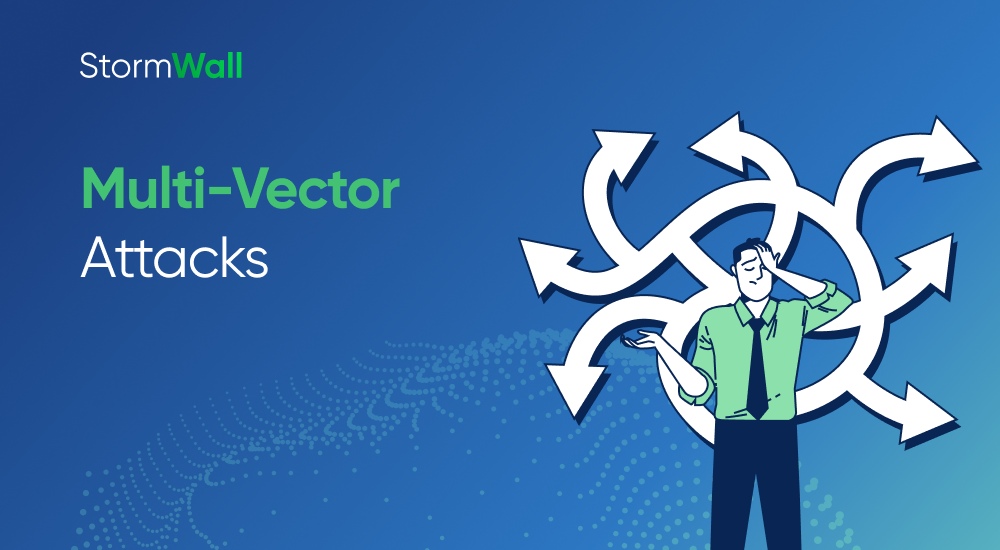Multi-vector DDoS attacks have emerged as one of the biggest challenges in cybersecurity today. The number of such incidents has been growing significantly year over year. In this article, we’ll break down what multi-vector attacks are, how they work, and why they’re such a pressing threat.

What Are Multi-Vector DDoS Attacks?
As DDoS attacks evolve, it becomes increasingly difficult to combat cybercrime. Attackers are continuously improving their technical tools and tactics. Against this backdrop, multi-vector DDoS attacks are becoming more widespread, impacting businesses worldwide.
A multi-vector DDoS attack combines different attack methods targeting multiple levels of the OSI model (L3, L4, L7) in the victim’s infrastructure. Hackers use a variety of techniques, including HTTP Floods, DNS amplification, and fake TCP sessions, among others.
Often, these attacks serve as a smokescreen for more sinister cybercrimes, such as brute-forcing passwords to access critical systems or stealing confidential data. In such cases, the damage can devastate an entire organization.
Compared to single-vector attacks, multi-vector DDoS attacks require a higher level of skill and expertise from attackers. However, they are also far more effective and destructive, making them a preferred method for cybercriminals aiming to maximize damage.
Why Are Multi-Vector DDoS Attacks So Prevalent?
The growing popularity of multi-vector DDoS attacks can be traced back to three key factors:
First, they cause maximum damage. By launching simultaneous attacks on multiple “fronts,” hackers increase their chances of overwhelming and disabling their target’s infrastructure. This method is also used for reconnaissance purposes: a multi-vector DDoS attack allows hackers to quickly identify weak points in the system and tailor subsequent attacks to exploit those vulnerabilities.
Second, they are hard to detect and counteract. Currently, there are no tools capable of conducting deep analysis of the signals that indicate the start of a multi-vector DDoS attack. Even when a company detects and mitigates the attack in time, there’s always the risk of missing other cybercriminal activities occurring simultaneously—like attempts to access sensitive data or compromise systems in other ways.
Finally, they exploit resource limitations. Organizations under attack often struggle to defend themselves due to limited cybersecurity and IT resources. Protecting all levels of a network requires time, effort, and coordination, which can overwhelm even skilled teams. Adding to the challenge, many companies use fragmented security tools based on different technologies and protocols. Managing this patchwork of solutions during a crisis—when every second counts—becomes a monumental task.
How to Defend Against Multi-Vector DDoS Attacks
The best defense against multi-vector DDoS attacks is to implement comprehensive protection across all layers of your infrastructure. To do this effectively, it’s essential to use centralized monitoring and management tools. Fragmented cybersecurity tools reduce a team’s ability to quickly detect and respond to multi-vector attacks, so having everything unified in one place is critical.
Fortunately, there are already providers offering advanced solutions tailored to defend against multi-vector DDoS attacks. For example, StormWall provides modern protection for websites (L3-L7), networks (L3/L4), and TCP/UDP services (L3/L4).
Monitoring performance indicators and configuring such solutions becomes far more convenient when everything is centralized. All tasks can be handled through a single interface, without switching between tools or applications. A centralized dashboard offers features like flexible performance metrics, traffic filtering settings, and management tools to protect against DDoS attacks at multiple levels.
Additionally, StormWall offers managed services with 24/7 technical support and expert assistance at every stage of implementing and managing protection against multi-vector DDoS attacks.
Why Choose Centralized Solutions?
- A single interface for all actions: All monitoring and mitigation tasks can be handled in one place, eliminating the need to juggle multiple platforms.
- Comprehensive tools in a unified dashboard: Flexible metrics and advanced traffic filtering settings enable efficient management of multi-layer protection.
Conclusion: Staying Ahead of the Threat
Multi-vector DDoS attacks are one of the fastest-growing threats in today’s cybersecurity landscape. By exploiting multiple vulnerabilities at once, they push organizations’ defenses to the limit.
To combat these sophisticated threats, businesses need robust, centralized security solutions that streamline monitoring, detection, and response.
With the right tools and expert support—such as the solutions offered by StormWall—organizations can effectively counter these attacks and protect their critical infrastructure from disruption and damage.

DDoS Protection for Websites
- Activate protection in 10 minutes
- 24/7 technical support




















